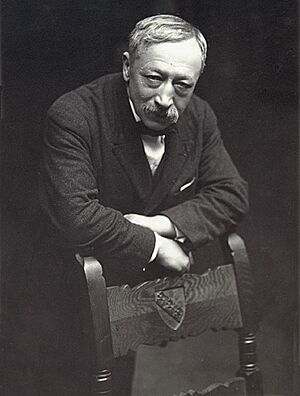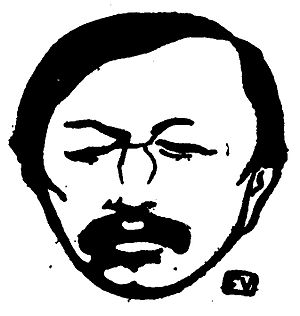Gustave Kahn facts for kids
Gustave Kahn (born December 21, 1859, in Metz; died September 5, 1936, in Paris) was an important French Symbolist poet and art critic. He helped define the Symbolism art movement and showed how it was different from the Decadent Movement through his writings and publications.
Contents
Gustave Kahn's Life
Kahn was from a Jewish family in Lorraine. He supported Émile Zola during the Dreyfus affair, a big political scandal in France. His wife, Elizabeth, even changed her name to Rachel and converted to Judaism to protest against antisemitism (prejudice against Jewish people).
Gustave Kahn's Poetry
Kahn said he invented the term vers libre, which means "free verse." This is a type of poetry that does not follow a strict rhythm or rhyme scheme. He was one of the first poets in Europe to use this style. Some of his main poetry books include Les Palais nomades (1887), Domaine de fée (1895), and Le Livre d'images (1897). He also wrote a valuable book about the history of the Symbolist movement called Symbolistes et décadents (1902).
Other Contributions and Works
Besides his poems, Kahn was a well-known public thinker who wrote novels, plays, and literary criticism (reviews and analysis of books). He was also very important in publishing Symbolist writings.
Publishing and Magazines
In 1886, Kahn, along with critics Félix Fénéon and Leo d'Orfer, started and managed a magazine called La Vogue. Through this magazine, Kahn and his partners helped new writers like Jules Laforgue and brought new attention to famous writers like Arthur Rimbaud. Rimbaud's famous manuscript, Les Illuminations, was published in La Vogue.
Kahn also co-founded and managed Le Symboliste with Jean Moréas. This journal was created to offer a different view from Anatole Bajule's Le Décadent, which they felt was not a true representation of Symbolist ideas. Kahn also played a key role in other important magazines like La Revue Indépendante, La Revue Blanche, and Le Mercure de France.
Art Criticism and Public Debates
Kahn was also an art critic and collector. He kept up with new developments in painting and sculpture throughout his life. He wrote a widely read article about the neo-impressionist painter Georges Seurat after Seurat's death, suggesting a Symbolist way to understand his art.
He also took part in many public discussions about important topics like anarchism, feminism, socialism, and Zionism. In the 1920s, he was the editor of Menorah, a Jewish magazine that stopped publishing in 1933.
Music and Legacy
In 1903, American composer Charles Loeffler created music for piano and voice using four of Kahn's poems from Les Palais Nomades. These poems were "Timbres Oublies," "Adieu Pour Jamais," "Les Soirs d'Automne," and "Les Paons."
After Gustave Kahn passed away, his original writings were added to the collection of the library at the Hebrew University of Jerusalem.
A Poem by Gustave Kahn
Here is a famous poem by Gustave Kahn called Les Paons (The Peacocks):
- Se penchant vers les dahlias,
- Des paons cabraient des rosaces lunaires,
- L'assouplissement des branches vénère
- Son pâle visage aux mourants dahlias.
- Elle écoute au loin les brèves musiques
- Nuit claire aux ramures d'accords,
- Et la lassitude a bercé son corps
- Au rythme odorant des pures musiques.
- Les paons ont dressé la rampe ocellée
- Pour la descente de ses yeux vers le tapis
- De choses et de sens
- Qui va vers l'horizon, parure vermiculée
- De son corps alangui.
- En l'âme se tapit
- le flou désir molli de récits et d'encens.
Main Books by Gustave Kahn
- Palais nomades (1887)
- Les Chansons d'amant (1891)
- Domaine de fée (1895)
- Le Roi fou (1896)
- La Pluie et le beau temps (1896)
- Limbes de lumières (1897)
- Le Livre d'images (1897)
- Premiers poèmes (1897)
- Le Conte de l'or et du silence (1898)
- Les Petites Ames pressées (1898)
- Le Cirque solaire (1898)
- Les Fleurs de la passion (1900)
- L'Adultère sentimental (1902)
- Symbolistes et décadents (1902)
- Odes de la "Raison" (1902)
- Contes hollandais (1903)
- La Femme dans la caricature française (1907)
- Contes hollandais (second series) (1908)
- La Pépinière du Luxembourg (1923)
- L'Aube enamourée (1925)
- Mourle (1925)
- Silhouettes littéraires (1925)
- La Childebert (1926)
- Contes juifs (1926)
- Images bibliques (1929)
- Terre d'Israël (1933)
See also
 In Spanish: Gustave Kahn para niños
In Spanish: Gustave Kahn para niños



